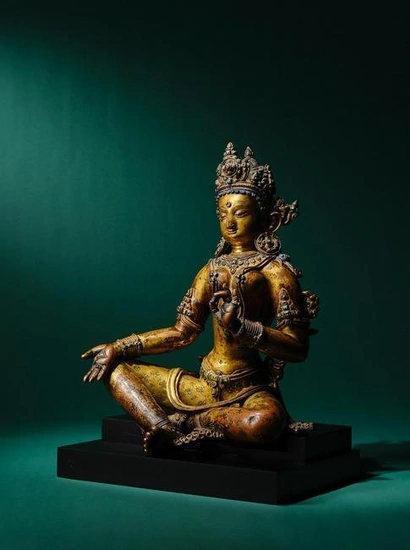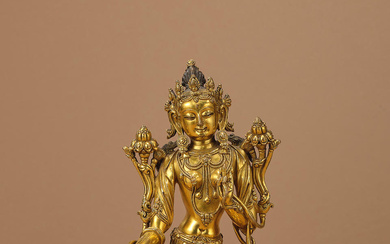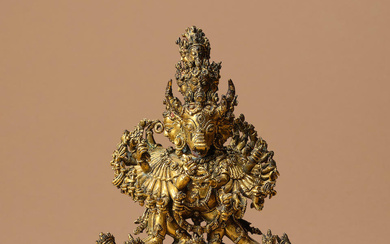A GILT COPPER ALLOY FIGURE OF TARA NEPAL, EARLY MALLA PERIOD, 14TH CENTURY
A GILT COPPER ALLOY FIGURE OF TARA
NEPAL, EARLY MALLA PERIOD, 14TH CENTURY
Himalayan Art Resources item no. 1410
13 5/8 in. (34.5 cm) high
Footnotes:
尼泊爾 馬拉王朝早期 十四世紀 銅鎏金度母像
Published:
Valrae Reynolds, 'The Zimmerman Family Collection', in American Collectors of Asian Art, Marg Publications, 1986, no. 4.
Pratapaditya Pal, Art of the Himalayas: Treasures from Nepal and Tibet, New York, 1991, no. 14.
Exhibited:
Art of the Himalayas: Treasures from Nepal and Tibet,
Newark Museum, New Jersey, 5 January – 1 March 1992;
Portland Art Museum, Oregon, 29 March – 24 May 1992;
Phoenix Art Museum, Arizona, 21 June – 16 August 1992;
The Helen Clay Frick Foundation, Pittsburgh, 13 September – 8 November 1992;
Virginia Museum of Fine Arts, Richmond, 28 February – 25 April, 1993;
Bowers Museum, Santa Ana, 22 May – 31 July 1993;
Tampa Museum of Art, Florida, 5 September – 31 October 1993;
National Gallery of Victoria, Sydney, February – April 1994;
Melbourne Museum, Melbourne, 1994;
Australian Museum, Sydney, April – June 1994;
Art Gallery of Western Australia, Perth, July – September 1994;
Musée Cernuschi, Paris, February – May 1996.
Provenance:
The Zimmerman Family Collection, since mid-1960s
From the renowned Zimmerman Family Collection assembled by Jack and Muriel Zimmerman, this stunning Nepalese Tara is a masterpiece of early Newari art. An early acquisition to the collection, it has been exhibited widely in the United States, Europe, and Australia. Impressive in scale and with a luxurious gilt and jeweled finish, this Tara exemplifies the Nepalese aesthetic of the youthful female goddess, at once sensuous and refined.
Of all the magnificent sculpture coming from the Indo-Himalayan region, Nepalese works of art are most revered for their aesthetic refinement. This impressively large (over 13' tall), bejeweled figure of Tara from the 14th century sits with her legs loosely crossed in the posture of royal ease, her hips swaying to the side. She extends one hand in the gesture of charity, an emblematic mudra expressing her compassion. The Nepalese artisan has sculpted the goddess with rounded breasts, a youthful body, and a benign countenance, a carryover from Indic influences which intertwined divine and sensual forms. That sensuality of form is further emphasized by the necklace, belt, and sash that fluidly curve around her body. A layer of gilding covers the glowing copper patina.
The intricate inlay of semi-precious jewels throughout her adorning jewelry further enhances the goddess's sublime beauty. The headband of diamond-shaped lapis insets along the crown underscores her soft curls, and the saturated blue complements the warmth of the gilded tones of her face. Rarely found intact in Nepalese pieces dating from any period are the strings of tiny pearls set in a crescent shape framing the central roundel of her crown. The earrings, lobes, pendants, clasps, bands, and rings each feature an arrangement of gemstones in colors of blue, green, turquoise, and maroon. Engraved floral motifs and loose tendrils decorate her lower garment, demonstrating a nimble spontaneity of line.
Devotional figures like these reached an artistic high point during the Early Malla period (13th-14th century), a time of both political and economic prosperity in Nepal. The Tara's gentle gaze, harmonious contours of the body and overlay of luxuriant surface detail are all typical of this distinctive Newari tradition that date this piece to the Early Malla period. These ritualized conventions of posture and expression are evident in other examples of the goddess, including a Tara dating to a similar period sold at Bonhams, (22 March 2022, New York, lot 305), whose taut yet fleshy figure and peaceful composure are echoed here. The figure's crown, featuring a large central roundel surmounting a crescent and flanked by two jewel-encrusted lobes, is indicative of this period. A similar crown can be seen in a figure of a Standing Maitreya formerly of the Maitri Collection (Bonhams, New York, 20 March 2018, lot 3205). The roundel earrings, wide cuff bracelets, lobed arm bands, and layered necklaces are closely related to a Syamatara of the 14th century also from the Maitri Collection (lot 3204). Her slender arching eyebrows, wide lids, rounded chin, and full lower lip are facial features shared by a Manjushri of the same period (Bonhams, New York, 22 March 2018, lot 3203), both conveying beatific expressions of quiescence.
In the Kathmandu Valley, the sixteen-year-old Buddhist goddess Tara was worshipped with immense fervor. Like her male counterpart, Avalokiteshvara, her compassionate and benevolent nature provided protection and reassurance amid the uncertainties of earthly existence. This promise extended beyond Buddhist circles into Brahmanical and regional sects, her limitless boons available to all worshipers.
These venerated images were executed with masterful metalworking techniques, a well-known and respected tradition of the Kathmandu Valley. The ability to cohesively balance corporeal forms and surface decoration demonstrates these artisans' proficiency with their material. The heavy copper content of the metal alloy provided the support for a thin layer of gilding to be laid on top, producing in this figure a luxuriant glow. Modelled to show density and mass as well as a rhythmic sway in the figure and her pleated sash, this Tara is a tribute to the metalworker's skill in mixing and pouring the molten metal during the casting process. So highly prized was this skill that Newari craftsmen were brought in to Tibet, Mongolia, and China, to share it.
Triumphs of artistic expression, as exemplified by this Tara, often directly correlate to a period of cultural growth driven by economic and political forces. The Early Malla period was the most prosperous in the history of the Kathmandu Valley. An enduring legacy for this fertile valley nestled along the Himalayas, surrounded by flourishing empires for the next several centuries, would be an aesthetic one. Each reigning empire sought to adopt the Newari aesthetic into their own visual idioms. It exemplifies a type of beauty, as seen here, of balanced counterpoints – mass and line, contour and ornament, expression and restraint – which renders images both earthly and sublime.
Sale price
Estimate
Reserve
Time, Location
Auction House
A GILT COPPER ALLOY FIGURE OF TARA
NEPAL, EARLY MALLA PERIOD, 14TH CENTURY
Himalayan Art Resources item no. 1410
13 5/8 in. (34.5 cm) high
Footnotes:
尼泊爾 馬拉王朝早期 十四世紀 銅鎏金度母像
Published:
Valrae Reynolds, 'The Zimmerman Family Collection', in American Collectors of Asian Art, Marg Publications, 1986, no. 4.
Pratapaditya Pal, Art of the Himalayas: Treasures from Nepal and Tibet, New York, 1991, no. 14.
Exhibited:
Art of the Himalayas: Treasures from Nepal and Tibet,
Newark Museum, New Jersey, 5 January – 1 March 1992;
Portland Art Museum, Oregon, 29 March – 24 May 1992;
Phoenix Art Museum, Arizona, 21 June – 16 August 1992;
The Helen Clay Frick Foundation, Pittsburgh, 13 September – 8 November 1992;
Virginia Museum of Fine Arts, Richmond, 28 February – 25 April, 1993;
Bowers Museum, Santa Ana, 22 May – 31 July 1993;
Tampa Museum of Art, Florida, 5 September – 31 October 1993;
National Gallery of Victoria, Sydney, February – April 1994;
Melbourne Museum, Melbourne, 1994;
Australian Museum, Sydney, April – June 1994;
Art Gallery of Western Australia, Perth, July – September 1994;
Musée Cernuschi, Paris, February – May 1996.
Provenance:
The Zimmerman Family Collection, since mid-1960s
From the renowned Zimmerman Family Collection assembled by Jack and Muriel Zimmerman, this stunning Nepalese Tara is a masterpiece of early Newari art. An early acquisition to the collection, it has been exhibited widely in the United States, Europe, and Australia. Impressive in scale and with a luxurious gilt and jeweled finish, this Tara exemplifies the Nepalese aesthetic of the youthful female goddess, at once sensuous and refined.
Of all the magnificent sculpture coming from the Indo-Himalayan region, Nepalese works of art are most revered for their aesthetic refinement. This impressively large (over 13' tall), bejeweled figure of Tara from the 14th century sits with her legs loosely crossed in the posture of royal ease, her hips swaying to the side. She extends one hand in the gesture of charity, an emblematic mudra expressing her compassion. The Nepalese artisan has sculpted the goddess with rounded breasts, a youthful body, and a benign countenance, a carryover from Indic influences which intertwined divine and sensual forms. That sensuality of form is further emphasized by the necklace, belt, and sash that fluidly curve around her body. A layer of gilding covers the glowing copper patina.
The intricate inlay of semi-precious jewels throughout her adorning jewelry further enhances the goddess's sublime beauty. The headband of diamond-shaped lapis insets along the crown underscores her soft curls, and the saturated blue complements the warmth of the gilded tones of her face. Rarely found intact in Nepalese pieces dating from any period are the strings of tiny pearls set in a crescent shape framing the central roundel of her crown. The earrings, lobes, pendants, clasps, bands, and rings each feature an arrangement of gemstones in colors of blue, green, turquoise, and maroon. Engraved floral motifs and loose tendrils decorate her lower garment, demonstrating a nimble spontaneity of line.
Devotional figures like these reached an artistic high point during the Early Malla period (13th-14th century), a time of both political and economic prosperity in Nepal. The Tara's gentle gaze, harmonious contours of the body and overlay of luxuriant surface detail are all typical of this distinctive Newari tradition that date this piece to the Early Malla period. These ritualized conventions of posture and expression are evident in other examples of the goddess, including a Tara dating to a similar period sold at Bonhams, (22 March 2022, New York, lot 305), whose taut yet fleshy figure and peaceful composure are echoed here. The figure's crown, featuring a large central roundel surmounting a crescent and flanked by two jewel-encrusted lobes, is indicative of this period. A similar crown can be seen in a figure of a Standing Maitreya formerly of the Maitri Collection (Bonhams, New York, 20 March 2018, lot 3205). The roundel earrings, wide cuff bracelets, lobed arm bands, and layered necklaces are closely related to a Syamatara of the 14th century also from the Maitri Collection (lot 3204). Her slender arching eyebrows, wide lids, rounded chin, and full lower lip are facial features shared by a Manjushri of the same period (Bonhams, New York, 22 March 2018, lot 3203), both conveying beatific expressions of quiescence.
In the Kathmandu Valley, the sixteen-year-old Buddhist goddess Tara was worshipped with immense fervor. Like her male counterpart, Avalokiteshvara, her compassionate and benevolent nature provided protection and reassurance amid the uncertainties of earthly existence. This promise extended beyond Buddhist circles into Brahmanical and regional sects, her limitless boons available to all worshipers.
These venerated images were executed with masterful metalworking techniques, a well-known and respected tradition of the Kathmandu Valley. The ability to cohesively balance corporeal forms and surface decoration demonstrates these artisans' proficiency with their material. The heavy copper content of the metal alloy provided the support for a thin layer of gilding to be laid on top, producing in this figure a luxuriant glow. Modelled to show density and mass as well as a rhythmic sway in the figure and her pleated sash, this Tara is a tribute to the metalworker's skill in mixing and pouring the molten metal during the casting process. So highly prized was this skill that Newari craftsmen were brought in to Tibet, Mongolia, and China, to share it.
Triumphs of artistic expression, as exemplified by this Tara, often directly correlate to a period of cultural growth driven by economic and political forces. The Early Malla period was the most prosperous in the history of the Kathmandu Valley. An enduring legacy for this fertile valley nestled along the Himalayas, surrounded by flourishing empires for the next several centuries, would be an aesthetic one. Each reigning empire sought to adopt the Newari aesthetic into their own visual idioms. It exemplifies a type of beauty, as seen here, of balanced counterpoints – mass and line, contour and ornament, expression and restraint – which renders images both earthly and sublime.







